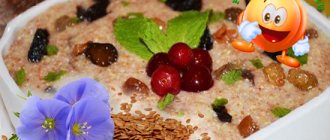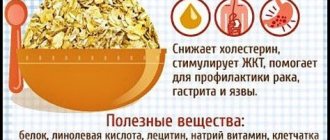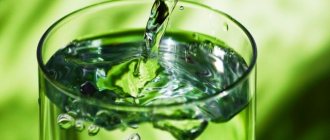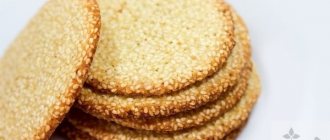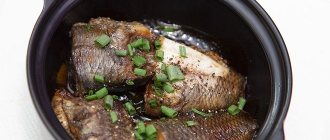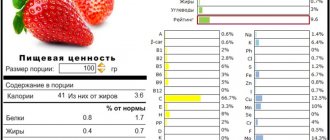Author: Kristina Lobanovskaya, doctor, practicing nutritionist Article updated: 11/09/2020
Semolina porridge is a well-known dish that all children of the Soviet era had for breakfast. Today it is still considered “children’s”, but its benefits have been questioned by experts. Not everyone will decide to lose weight on such a product either, and all because of the calorie content of semolina porridge: according to most people, it has too high an energy value. Is this really so and what is the calorie content of the product in one form or another?
Dry
Porridge is prepared from semolina, which is nothing more than finely ground wheat. The diameter of the grains ranges from 0.25 to 0.75 mm. The cereal quickly boils, again, thanks to grinding, and is perfectly absorbed by the body. Due to its minimal fiber content, liquid semolina porridge is recommended to be included in the diet in the presence of diseases of the gastrointestinal tract. This is one of the first beneficial properties of cereals. In addition, semolina fills the body with energy, helps restore physical strength, and also cleanses and removes fat.
Despite the lack of fiber, the composition of the cereal is quite diverse. It contains starch, proteins, vitamins E and group B, as well as many minerals. It also contains gluten, known as gluten. Gluten is viewed controversially by most scientists because it leads to thinning of the intestinal mucosa and interferes with the absorption of nutrients. In addition, it is “gluten” that often causes allergies. Another very controversial substance in cereals is phytin. It has the ability to bind calcium salts, preventing its absorption. And yet, such moments do not negate the benefits and excellent taste of porridge. For a long time, semolina has been popular all over the world.
Semolina is used relatively infrequently as a product for weight loss, which is due to its high calorie content compared to other cereals - 333 kcal for every 100 grams. However, you should know that after cooking, cereal loses a significant part of its calories, so it becomes quite appropriate on the dietary table.
Since no one eats semolina in dry form, it is a mistake to consider it a high-calorie product.
The main thing to achieve the effect and benefit is to follow a number of simple rules when choosing a product:
- Choose cereal in a plastic bag, since such packaging prevents it from coming into contact with moisture.
- Give preference to porridge that has the “GOST” mark on its packaging.
- Purchase only clean goods, without suspicious impurities.
After purchasing, the cereal must be transferred to a glass container and sealed tightly. In this case, its shelf life can be extended to 10 months.
Contraindications
For certain diseases, semolina porridge is contraindicated. It can cause harm to people suffering from the following diseases:
- Celiac disease. Gluten content negatively affects the body of people with this hereditary disease. Eating porridge may be accompanied by indigestion and an allergic reaction.
- Some endocrine diseases. It is not advisable to eat semolina if you are obese or have insulin-dependent diabetes.
- Joint diseases. It is not recommended to add semolina porridge to the diet for gout and osteoporosis.
- Bronchial asthma.
It is not recommended to eat semolina porridge while breastfeeding, since it often causes an allergic reaction in the baby.
On the water
Semolina porridge cooked in water, especially without the use of butter and other additives, is an excellent dietary product that can be consumed if you want to cleanse the body and normalize the functioning of the digestive tract. Unlike a dry product, it is completely harmless to the figure: the calorie content of semolina porridge with water is 80 kcal per 100 grams. The dish is considered a good alternative to milk porridges for those who suffer from lactose intolerance. If you add sugar during the cooking process, the calorie content will increase to 120 kcal per 100 grams. When preparing porridge in water without sugar, but with butter, the calorie content is 101 kcal per 100 grams. To give “lean” porridge a rich taste and nutritional value, you can use both ingredients at once. The calorie content of porridge with sugar and butter is 137 kcal per 100 grams, which is also quite acceptable for a weight loss diet.
Semolina is a source of valuable proteins. Its use along with regular physical activity can significantly transform your figure.
Like cereals, ready-made semolina supplies the body with vitamins and minerals, which helps prevent many diseases. Experts note that eating “lenten” semolina is a sure way to normalize the activity of the nervous system, produce blood cells and obtain energy for the full functioning of the whole body. It has been proven that even a small portion of this porridge helps relieve pain and cramps from ulcers and gastritis.
The classic recipe for making porridge with water provides a ratio of 1:4 (medium-thick semolina). There are several cooking methods: you can pour the cereal into cold water and cook for several minutes after boiling, or pour it into boiling water and boil for no more than 1 minute. The main thing is to stir vigorously to avoid lumps. The finished product should be stored in the refrigerator, but it is better to consume it immediately after preparation.
Mannik BZHU
There are many recipes for manna: with water or kefir, with or without eggs. The amount of granulated sugar is also different. It is the composition of the ingredients and their quantity that determines the calorie content of the product and how many carbohydrates it contains. 218 calories, that is, 14.24% of the daily intake - this is the energy value of a hundred-gram piece of manna prepared from a glass of semolina, the same amount of kefir, one egg and half a glass of sugar. BJU of manna per 100 grams of product is calculated as follows:
- proteins – 6.2 g (6.74%);
- lipids – 2.4 g (3.58%);
- carbohydrates – 45.9 g (32.79%).
So, semolina dishes are not only tasty, but also healthy, provided they are prepared correctly. It is no coincidence that this product is included in the menu of patients who have undergone surgery: semolina promotes wound healing, normalizes hemoglobin levels, and improves the functioning of the liver and gastrointestinal tract.
Semolina is also recommended for pregnant women, as it helps the fetus to develop properly. Thanks to the consumption of semolina, efficiency increases, vitality increases, and reserves of lost energy are replenished.
With milk
Semolina cooked with milk turns out nutritious and tender. It contains simple carbohydrates that give you quick satiety and a burst of energy. It is absorbed almost completely, without injuring the stomach. All thanks to the lack of fiber - there is no more than 2% of it in the product.
Despite the large amount of simple carbohydrates, the dish can be used for weight loss. Experts have even developed several special diets, one of which involves consuming exclusively milk semolina.
The calorie content of semolina porridge with milk is only 98 kcal, which is not much higher than that cooked in water. You can increase your calorie content with additional ingredients:
- with sugar but without butter – 101 kcal per 100 g;
- with butter, without sugar – 155 kcal per 100 g;
- with butter and sugar – 113 kcal per 100 g.
It should be borne in mind that when losing weight, you should not use the fattest milk and try not to overload the porridge with butter, adding a small piece when serving.
There is another interesting option for preparing semolina for those who are not ready to give up milk - cooking with milk and water (in a dairy farm). Liquid components are taken equally. The calorie content of such a dish is at the level of 80 kcal per 100 g. If you add a little sugar additionally, the calorie content will increase to 107 kcal for every 100 g.
The process of preparing semolina in milk is similar to the method of boiling in water, that is, the cereal can be poured into cold or boiling liquid. Intensive stirring is necessary.
Semolina porridge and weight loss
One could easily turn a blind eye to the number of calories in the dish, because a serving of the same buckwheat porridge, for example, with boiled chicken and tomatoes, also comes out to 300-350 kcal. This is an acceptable amount for breakfast and lunch; for dinner, experts advise reducing it to 250 kcal. However, the problem with semolina porridge is that it practically does not fill you up. Due to the way grain is processed, the dish is a source of simple carbohydrates, which immediately raise blood glucose levels and very quickly lower them. As a result, after half an hour or an hour you feel hungry again.
If you decide not just to maintain your figure, but to lose weight, you will have to give up semolina porridge completely (even small portions are unacceptable), because constant insulin surges disrupt metabolic processes and lead to disruptions in the functioning of the endocrine system. And this is a direct path to both excess weight and diabetes: in both situations, semolina porridge is, again, strictly prohibited.
However, if you definitely shouldn’t use semolina porridge to lose weight, then if you are underweight, it can help you gain a couple of kilograms. However, it is important to be careful here, since it is better to increase weight with muscle mass, not fat – semolina can seriously increase the amount of the latter.
Dishes
Semolina porridge is not only a complete food product that can be supplemented with fruits, vegetables, etc., but also an ingredient for creating quite unexpected dishes. The delicate taste of the finished porridge can diversify your daily and dietary diet.
Baked
The classic recipe for making semolina involves boiling, but baked porridge turns out much more appetizing. The calorie content of the finished product is not low - about 339 kcal per 100 g, but it satisfies quickly and for a long time.
To prepare a volume suitable for 6 servings, take 2 cups of regular oatmeal without additives. In a bowl, combine with a glass of low-fat yogurt, again without additives. Mix well and add 1 cup of semolina. After 30 minutes, add one raw chicken egg and 100 g of steamed raisins. Add half a cup of granulated sugar. Mix thoroughly. The baking dish is greased with vegetable oil. Place the mass in it and cook at a temperature of 180 degrees for 40 minutes.
With banana
Semolina with banana is ideal for breakfast. The sweet fruit gives the porridge an unexpected taste without adding much calories - 116 kcal per 100 g. The dish is prepared using milk, which makes it nutritious and tender.
Pour a glass of cold milk into the pan and add 2 tablespoons of semolina. Bring to a boil over low heat and cook for another 3 minutes with constant stirring. Place a tablespoon of granulated sugar and a finely chopped sprig of rosemary on a hot frying pan. Banana cut into slices is also sent there. To prevent the banana from losing its shape, frying is done quickly. Semolina is poured into a plate, and a fragrant caramel banana is placed on top.
The dish not only saturates the body with vitamins and minerals, but consuming it in the morning will prevent problems with the cardiovascular system and improve the digestion process. This is all thanks to the potassium content in bananas.
With dried apricots and raisins
A diet based on semolina porridge gives excellent results, but not everyone can use it regularly, and even in its classic form. The recipe with dried apricots and raisins is just for those. With a relatively low calorie content - 154 kcal per 100 g - and nutritional value, the dish provides gastronomic pleasure. By the way, this is one of the recipes for which “milk water” is used.
In a saucepan, combine a glass of water and low-fat milk. Add 2 tablespoons of granulated sugar and 1 teaspoon of salt. Place on fire, stir and heat, but do not bring to a boil. Remove from heat. 70 g of large raisins and 100 g of dried apricots are thoroughly washed and soaked for 20 minutes in warm water, then squeezed and crushed. The milky liquid is returned to the fire and heated. Add 1 cup of semolina and stir quickly to prevent the formation of lumps. Without ceasing to stir, add dried apricots and raisins. Stir until the semolina completely thickens. Remove from heat, cover with a lid and leave to steep for 15 minutes.
The dried fruits used in the recipe give the finished product a special taste and help increase its benefits for the body. Firstly, it becomes possible to increase the level of hemoglobin in the blood and have a positive effect on the functioning of the heart muscle. Secondly, prevent disorders in the functioning of the nervous system and improve sleep.
With carrots
Semolina is equally good in combination with fruits and vegetables. Adding carrots is a great way to fortify a dish. The vegetable is recommended for bronchitis, anemia, and vision diseases. In addition, it is an antiseptic, choleretic, analgesic and anti-inflammatory natural remedy that additionally strengthens hair and normalizes complexion. 100 g of semolina with carrots contains only 119 kcal, so it is suitable for use when losing weight.
Place a small piece of butter in a saucepan. Wait for it to heat up and add a little sugar. Grate the carrots on a fine grater and place in a saucepan. Simmer for about 5 minutes with constant stirring. A glass of warm milk is added to the carrots. After a few minutes, gradually add 2 tablespoons of semolina. Stir and cook for 4 minutes.
Chocolate
Cocoa powder will help transform a dish from a tasteless white mass into a gastronomic pleasure. Additionally, the recipe includes raspberries, due to which the semolina is saturated with even more vitamins. The dish looks especially useful for people with low immunity and impaired metabolism. Cocoa also has benefits, as it contains a large amount of antioxidants.
Pour 2 cups of milk into a saucepan. Heat, add 2 tablespoons of sugar and a pinch of salt. Pour 3 tablespoons of cereal into well-warm, but not boiling milk. Cook, stirring constantly, for 5 minutes. Add 2 tablespoons of cocoa powder and cook for another 1 minute. Once cooking is complete, add a handful of fresh or frozen raspberries.
Dessert
If you have ready-made milk semolina left in the refrigerator, you can use it to prepare an unusual dessert, the calorie content of which is 149 kcal per 100 g. For those losing weight, the dish looks like a good alternative to high-calorie baked goods.
Heat 500 g of semolina, add 20 g of butter and let it dissolve, then mix. Take a deep plate and moisten it with a small amount of water. Place a tablespoon of cherry jam on the bottom, then cover with half a portion of semolina. Then again there is a layer of jam, but this time from 2 tablespoons. Spread the remaining porridge on top. Cover the plate with foil and put it in the refrigerator for 2 hours. After the time has passed, the foil is removed and the plate is turned over onto a plate. Sprinkle the dessert with a few teaspoons of cocoa powder.
Properties of semolina porridge
How much does semolina porridge cost (average price for 1)?
White, viscous, sometimes with lumps, with a sweetish aftertaste - semolina porridge is known to almost all Soviet children, whose mornings began with just such a breakfast. Previously, the benefits of semolina porridge were an indisputable fact, and therefore it was recommended to introduce it to children from the age of six months.
Today, when the food industry has stepped far forward, it has become clear that the beneficial properties of semolina porridge are not so clear, and some experts claim that it can not only bring benefits, but also negatively affect the human body.
Semolina porridge is not only a complete food product, but also the main ingredient that can be used in the preparation of a number of delicious dishes. Take, for example, a variety of casseroles, pancakes, pancakes or gnocchi (a kind of dumpling).
The nutritional value
The benefits of semolina porridge lie in the vitamin and mineral composition of the cereal itself. Despite the fact that its value in comparison with other cereals is small, the calories are not “empty” at all. In addition to enveloping starch, semolina contains saturated fatty acids, mono- and disaccharides. Since semolina is a product of wheat processing, it contains much more protein than other cereals - as much as 12%. The dish is considered very suitable for athletes and people accustomed to leading an active lifestyle. It is not for nothing that semolina is classified as a product suitable for mono-diets: it contains all the substances necessary for the body, so additives can only be used to diversify the taste.
Proteins fats carbohydrates
The ratio of BJU depends on the method of preparing the porridge and the additional products used in the process, however, carbohydrates are the main source of energy for the human body.
Dry semolina, known as a high-calorie product, has the following BJU indicators:
- proteins – 10.3 g;
- fats – 1 g;
- carbohydrates – 70.6 g.
When boiled in water, the calorie content decreases, and significantly. BZHU indicators are also undergoing changes:
- proteins – 2.5 g;
- fats – 3.2 g;
- carbohydrates – 16.8 g.
At the same time, adding sugar slightly increases the level of proteins (3.2 g) and reduces the level of carbohydrates (15 g). If you use butter, the latter will be even larger - 19.7 g. You can also add both ingredients at the same time, obtaining the following indicators for every 100 g:
- proteins – 3.7 g;
- fats – 4.1 g;
- carbohydrates – 18.1 g.
The calorie content of a 100 gram serving of semolina cooked in milk is 98 calories. The BJU ratio is as follows:
- proteins – 1.6 g;
- fats – 2.7 g;
- carbohydrates – 11.5 g.
If you add sugar, the calorie content will increase to 101 kcal. The BZHU indicators will also change slightly:
- proteins – 3.2 g;
- fats – 2.7 g;
- carbohydrates – 16.5 g.
The calorie content of semolina porridge with butter, cooked in milk, is 155 calories per 100 grams. If you want to do without sugar, the ratio will be as follows:
- proteins – 4.1 g;
- fats – 7.9 g;
- carbohydrates – 17.8 g.
Semolina can be cooked with milk using both components, which will also affect the calorie content - 113 kcal - and BJU indicators:
- proteins – 3.1 g;
- fats – 5.7 g;
- carbohydrates – 12.5 g.
When cooking cereal in a “milk tank”, the calorie content of a 100 gram serving will be 80 calories. The dish will have the following meanings:
- proteins – 2.3 g;
- fats – 1.3 g;
- carbohydrates – 12.3 g.
Baked semolina with the addition of oatmeal and raisins has a high calorie content - 339 kcal for every 100 grams and includes:
- proteins – 8 g;
- fat – 6 g;
- carbohydrates – 65 g.
Macro- and microelements
Semolina is a storehouse of minerals important for the body. Along with the most well-known and familiar to humans, such as calcium and iron, it contains unexpected minerals that play an important role in providing benefits to all organs and systems.
- Titanium – takes part in the formation of red blood cells in the bone marrow, supports the immune system and is involved in the synthesis of hemoglobin.
- Tin – enhances growth processes, promotes proper skeletal development, and is part of gastric enzymes.
- Nickel - activates a number of enzymes, participates in fat metabolism and enhances the passage of redox processes in tissues, that is, it provides them with oxygen.
- Aluminum – increases the digestive ability of gastric juice, takes part in the construction of bone and connective tissue, and helps in epithelization of the skin.
- Cobalt - participates in the process of hematopoiesis, regulates the functioning of the central nervous system, normalizes the activity of the pancreas.
- Silicon - affects brain function, helps lower blood pressure, normalizes metabolism (acts as a catalyst for multiple redox processes).
- Vanadium – supports the cardiovascular system, is involved in the regulation of carbohydrate metabolism and has a beneficial effect on the functions of the liver and kidneys.
- Boron - improves the metabolism of calcium, fluorine and phosphorus, while participating in the regulation of the nervous system and enzymatic processes.
- Molybdenum – promotes the metabolism of fats, carbohydrates and proteins, while normalizing sexual function and stimulating body growth.
- Fluoride – strengthens the bone skeleton and tooth enamel, increases the body’s defenses, and suppresses the activity of pathogens.
- Chromium – regulates the functioning of the cardiovascular system and thyroid gland, helps prevent the development of osteoporosis.
- Manganese – improves the functioning of the central nervous system, participates in the metabolism of vitamins E and C, and has antioxidant properties.
- Copper – participates in hematopoiesis processes, normalizes the functioning of the endocrine system, improves digestion.
- Zinc – regulates the functioning of the central nervous system and gonads, helps in the rapid healing of wounds.
- Iron – participates in intracellular metabolic processes, affects the metabolism of B vitamins, and ensures the transport of oxygen in the body.
- Sulfur – strengthens muscle tissue, helps in removing waste and toxins from the body, stabilizes blood sugar levels.
- Chlorine – helps eliminate swelling and remove toxins from the body, helps in the breakdown of subcutaneous fat, and improves the functioning of the liver.
- Phosphorus - is important for kidney health and metabolism, activates the action of vitamins, is necessary for normal heart function, strengthens teeth and gums.
- Potassium is extremely important for maintaining heart health and normal functioning of soft tissues, and helps eliminate swelling.
- Magnesium – is involved in the functioning of the central nervous system, improves the functioning of the digestive organs, and supports heart health.
- Calcium – helps strengthen the bone skeleton and teeth, has an anti-allergenic effect, and has an anti-stress effect.
The mono-diet on semolina is well tolerated precisely because of the huge amount of minerals included in its composition, which act together.
Vitamins
Despite the fact that semolina cannot boast of a wide list of organic compounds, it contains the content of the most important vitamins for the health of the body, mainly group B:
- PP (niacin or B3) – is involved in the metabolism of amino acids, fats and proteins, and is additionally considered an important component of tissue respiration and redox processes.
- E (tocopherol) – is a powerful antioxidant, supports the immune system, improves cellular nutrition.
- B9 (folic acid) – actively participates in the regulation of the functions of the hematopoietic organs, has a positive effect on the functioning of the liver and intestines.
- B6 (pyridoxine) – lowers cholesterol levels, improves the contractility of the heart muscles, and promotes better absorption of glucose by nerve cells.
- B2 (riboflavin) - acts as a participant in all types of metabolic processes, plays an important role in the functioning of the visual organs.
- B1 (thiamine) – is involved in fat, carbohydrate, water-salt and energy metabolism, and also improves the condition of the cardiovascular and nervous systems.
To get the maximum benefit from semolina porridge, it is enough to eat just one serving a day - 250 grams. It is better if it is prepared without harmful additives in milk. Since this is the only cereal that can cleanse the intestines of mucus, its use is definitely useful for those who want to put all organs of the gastrointestinal tract in order. There are also pitfalls of regularly including the dish in your diet. For example, a high gluten content can provoke an allergic reaction and interfere with the absorption of nutrients from food. When deciding to use semolina as a diet product for weight loss, this should be taken into account first. Semolina is also a morning product, so it is better to refrain from consuming it in the evening.
Composition of semolina
The nutritional value of semolina and its nutritional properties are related to the type (variety) of crushed grain. The product supplies the body with a very significant proportion of essential substances - microelements, fiber, proteins and carbohydrates.
The product content as a percentage of the daily intake norm is shown in the table:
| Vitamins | Quantity per 100 g of product | % of normal use |
| PP (nicotinic acid) | 3 mg | 15 |
| E (tocopherol) | 1.5 mg | 10 |
| B6 (pyridoxine) | 0.17 mg | 8,5 |
| B1 thiamine) | 0.14 mg | 9,3 |
| B2 (riboflavin) | 0.04 mg | 2,2 |
| B9 (folate) | 23 mcg | 5,8 |
| Minerals | ||
| Manganese | 0.44 mg | 22 |
| Chlorine | 21 mg | 0,9 |
| Copper | 70 mcg | 7 |
| Molybdenum | 11.3 mcg | 16,1 |
| Chromium | 1 mcg | 2 |
| Zinc | 0.59 mg | 4,9 |
| Cobalt | 25 mcg | 250 |
The benefits and harms of semolina
Experts say that the opinion inculcated from childhood about the extreme usefulness of semolina porridge for a growing body is too exaggerated, although it certainly has certain positive qualities. For example, if we touch on the topic of the vitamin-mineral complex contained in semolina, it is quite rich:
- B vitamins;
- vitamins of group E;
- potassium;
- calcium;
- magnesium;
- zinc;
- phosphorus.
B vitamins are responsible for the quality functioning of the human nervous system, and also maintain the digestive tract in normal condition. They also help stabilize blood sugar levels. But vitamins of group E, in addition to also having a beneficial effect on the functioning of the nervous system and even the brain, are also a strong antioxidant (in simple terms, antioxidants are substances that “heal” damaged cells of the body and protect them from destruction).
Potassium is responsible for the normal functioning of the kidneys and for the normalization of cardiac processes. Magnesium maintains muscle, bone and nerve tissue tone. Calcium also contributes to bone strength. Phosphorus helps absorb energy. Zinc strengthens the immune system. As a result, this entire serious set is extremely useful, in particular for older people, for whom strengthening bones is especially important.
But there are a number of contraindications to eating this dish, which apply to absolutely all children under one year of age, as well as people with some specific diseases. Many pediatricians do not recommend giving semolina to babies because of the huge amount of starch it contains - about 70%. Breasts are simply not able to cope with such a volume of carbohydrates. But children from one to three years old can be fed this dish, but not more than once or twice a week. In any case, in order not to take risks, you should definitely consult a pediatrician on this issue. As for adults, this product is not recommended for people: with lactose and gluten intolerance due to the risk of allergic reactions; with diabetes mellitus; women during pregnancy and lactation.
Semolina is unique in that the process of its digestion occurs mainly in the lower intestines, from which it removes accumulated fats and mucus. Experts also note that regular consumption of semolina porridge in reasonable quantities will help a person not only reduce cholesterol in the body, but even control their weight. And this brings us to debunking the main myth about semolina, which says that it plumps up by leaps and bounds.
In fact, there is even a semolina diet that can help you lose a few extra pounds. This is a mono-diet designed for 5 days, during which it is possible to lose three to five kg. Its essence is that during all days of the diet a person eats exclusively semolina porridge cooked in water or low-fat milk. But you can’t add sugar, butter, or other goodies to it. The calorie content of one hundred grams of such a dish will be only 80–90 kcal. Even if you eat it four times a day, 200 grams each, the total figure for the day will be only 640–720 kcal. The daily diet is diluted only with green tea.
Since this dish is rich in carbohydrates, it can also be easily used to quickly gain weight for people who need it. In this case, you need to adhere to diametrically opposed requirements: do not give up additives, but put butter, sugar, and even condensed milk in the semolina. And for greater effect, you can drink it with milk and eat it as a snack with a fresh loaf.
Varieties of cereals
The semolina particle size ranges from 0.3 to 0.8 mm, which depends on the source material - wheat.
For proper use of the product, you should take into account the accepted labeling of cereals:
- Category "M" - semolina made from soft grains. It is distinguished by a white tint and opaque structure. It is cooked without lumps, the volume of the finished food increases several times.
- Category “T” - cereals produced from durum cereal varieties. It has a yellowish tint and translucent particles. Practically does not swell during cooking.
- Category “MT” is a mixture of soft (80%) and hard (20%) varieties. A universal type of cereal, suitable for both porridge and confectionery.
Information about the semolina variety, expressed in letter designation, should be found on the manufacturer’s packaging.
